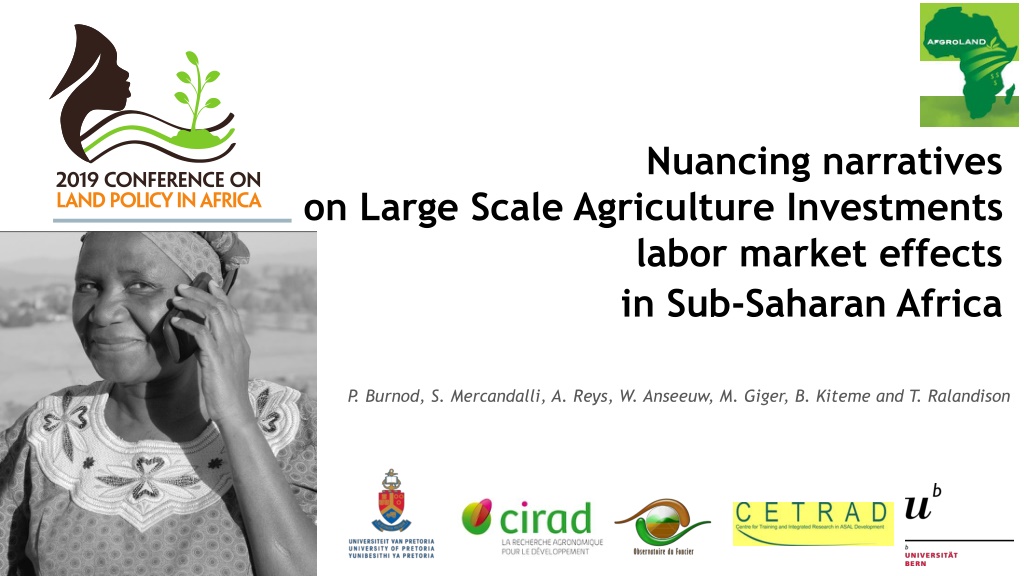Nuancing Narratives on Large-Scale Agriculture Investments' Labor Market Effects in Sub-Saharan Africa
Exploring the impacts of Large Scale Agriculture Investments (LAI) on job creation in Sub-Saharan Africa, focusing on labor market dynamics, supply and demand sides analysis, and case studies from Kenya, Mozambique, and Madagascar. The research delves into the quantity and quality of jobs created, identifying who benefits from these investments and their implications for local communities and households.
Download Presentation

Please find below an Image/Link to download the presentation.
The content on the website is provided AS IS for your information and personal use only. It may not be sold, licensed, or shared on other websites without obtaining consent from the author. Download presentation by click this link. If you encounter any issues during the download, it is possible that the publisher has removed the file from their server.
E N D
Presentation Transcript
Nuancing narratives on Large Scale Agriculture Investments labor market effects in Sub-Saharan Africa P. Burnod, S. Mercandalli, A. Reys, W. Anseeuw, M. Giger, B. Kiteme and T. Ralandison
Context: #CLPA2019 Employment in Sub-Saharan Africa => 375 million young actives will enter the labor market in the next 15 years. Debate on Large Scale Agricultural Investment (LAI) & jobs creation Need of information based on several cases Need to overcome simplistic narratives on LAI labor and other socioeconomic impacts
Research question #CLPA2019 What are the direct impacts of LAIs in terms of jobs creation ? Who get the jobs? Originality of the research : to analyze labor impact both on the supply and demand sides
3 countries: 3 contrasting contexts, with different levels of agricultural investments #CLPA2019 Kenya: Nanyuki area =many longstanding investments, notably in the horticultural sector Mozambique: Nacala corridor = high number of new investors present thanks to pro-investment policies Madagascar: lots of projects announced, 95% collapsed and only few companies have continued : [2000-2017 period]
impacts on labor supply #CLPA2019 Quantity and quality of jobs created? Production models and contexts matter
Data Collection #CLPA2019 Agricultural farms MOZAMBIQUE study area KENYA study area MADAGASCAR study area Step 1 : LAI companies level : Inventory & Qualitative assessment of business models => qualitative interviews with Cies 64 95 # Companies (inventory) 25 34 20 # interviewed companies 14 33 1 13 # Still active / Retained for assessment Table 1 : companies census in study areas according to country. sources Cetrad and CDE, ILC and Cirad, Malgasy Land Observatory
Quantity of created jobs per company (2016) MOZAMBIQUE 13 KENYA 33 MADAGASCAR Nb of companies assessed #CLPA2019 1 Permanent jobs (PJ) Average PJ /company 94 165 95 Temporary jobs (TJ) Average TJ / company 456 71 200 Households Nb of HH in the study area 162 000 200 000 1 000 % potentially impacted HH 5% 3,5% 30%
Quantity of created jobs depend on production model Area Mechani zation Proces sing Nb of Perm/ 100 ha 210 1740 6 6 3 Nb of cultivated /farm 21 33 #CLPA2019 Temp/ 100 ha 225 220 1 22 4 Vegetables /mixed Roses Cereal Maize Soybean (moz) Maize Soybean (mada) Partial no yes 950 3 500 yes no Sisal 1 40 1500 - 2000 no yes Tea Meringa,macadamia. 9 71 4 12
Quality of jobs depends on company and local context #CLPA2019 89 % 80 % 65 % 42 % 36 % Mad. 24 % Mad. Moz. Ken. Moz. Ken. % with formal contract % of permanent workers
Attractiveness of jobs depends on local context #CLPA2019 MOZ 3 cases KENYA - Nanyuki MADA - Satrokala MNZ KS MGA Level of remuneration per day (local unit) Agribusiness jobs 80 to 120 320 7 500 Non-agriculture employment* 80 to 220 420 3 500 Self employment 90 to 100 250 2 900
LAIs vs family farming : job created per 100 cultivated hectare Commercial farms Kenya Family farms Kenya #CLPA2019 Area Nb of PJ/ 100 ha Nb of TJ/ 100 ha Area Nb of PJ/ 100 ha crop crop cultivated /farm cultivated /farm 31 225 210 1,02 Mixed - veg Veg 212 23 220 1740 1,07 Mixed Roses 160 952 1 6 1,07 mixed Cereal 160
LAI labor impacts on the demand side #CLPA2019 Who benefit from the jobs? Differentiated workers and household profiles
Data Collection #CLPA2019 Households livelihoods survey 500 to 600 HH per study area in factual and counterfactual zones Households were randomly selected
Jobs opportunities for women ? Yes. % of female permanent workers % of female workers #CLPA2019 56 % 54 % 45 % 23 % Mad. 15 % Moz. Ken. - Moz. Ken. Mad. In large most cases, only 1 member in the household is working for an agribusiness. Kenya: women represent half of the (permanent) workers ; Madagascar: women represent half of the workers but only 23% of the permanent; Mozambique: women are seldom employed as workers.
Jobs opportunities for migrants ? Yes but specially far migrants #CLPA2019 Majority of workers are migrants : 80% (Kenya & Mada); 50% (Moz) Coming from neighboring localities (Kenya), from remote localities (Moz & Mada)
Jobs opportunities for the ones who lost land? #CLPA2019 In Kenya: no HH lost land in the studied area roses and vegetable farms used former private land already allocated to commercial farms In Mozambique: 22 to 45% of the HH lost land (farmers used to occupy former state farm or customary land) In Madagascar: 8% of HH lost land mainly large grazing land for cattle In Madagascar and Mozambique: HH who lost land benefit less from jobs than other HH
To conclude.on agricultural models and pubic policy #CLPA2019 policy orientations toward: labour intensive business model choices ; imposition of minimum labor conditions/ wage ; Quantity and quality of LAI jobs do not justify displacement of farmers























